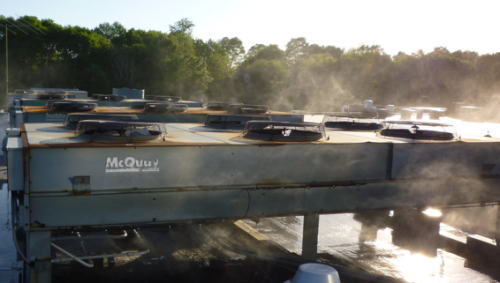
Benefits
- Increase peak ambient cooling capacity
- Decrease peak electrical demand (kW)
- Reduce energy usage (kWh)
- Extend compressor life
- Lower maintenance costs
- Minimize water & sewerage costs
- Thermostatically controlled
- Rapid simple installation
Operation and Savings
Energy Mist is a proprietary RetroCool technology that was designed to improve the upper ambient performance of air-cooled refrigeration and air conditioning systems. These systems perform at their very worst at the exact time when they are needed most. On hot summer days, the same system that produces 95 tons of cooling when the ambient temperature is 85° F produces just 82 tons at 115° F, a 14% reduction in capacity. Over that same range, the power draw increases by 31%!
Historically, in order to increase cooling capacity, technicians have placed water sprinklers under condensers. As these must be turned on and off manually, water and sewage costs tend to escalate and roof leaks may be exacerbated.
Energy Mist is a far better solution. By directing a fine pressurized water mist into the condenser air, its temperature is reduced. This increases cooling capacity while lowering electrical demand, energy use, and water costs. Perhaps of greatest importance, Energy Mist is extremely affordable and simple to install.
How Energy Mist Works

Water is fed to the inlet of a positive displacement pump mounted inside a heavy-duty cabinet. Upon receiving a signal from an integral thermostat or energy management system, the pump is energized and the water pressure is raised to the desired level. The cabinet contains pre-filtration, diagnostic LED lights and gauges, and high-pressure rated fittings. The pressurized water then flows through high-pressure tubing to Mist Bars that contain atomization tips spaced 9″ apart for maximum coverage. The bar is mounted in an adjustable holder that provides for simple redirection of the mist. Magnets on the bottom of the bar allow for rapid, simple installation. The mist bars are placed around the perimeter of the condensing coil and the mist is directed into the incoming condenser air, lowering its temperature and reduced system head pressure. This increases cooling capacity while decreasing peak demand.



